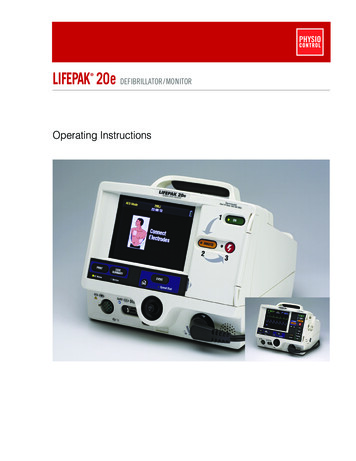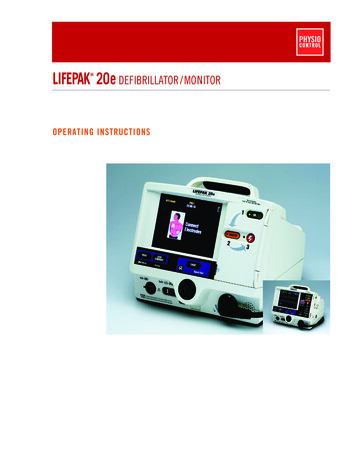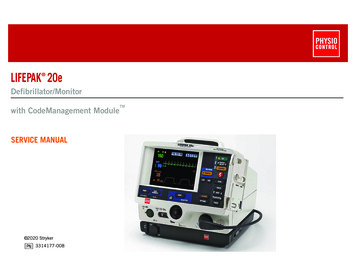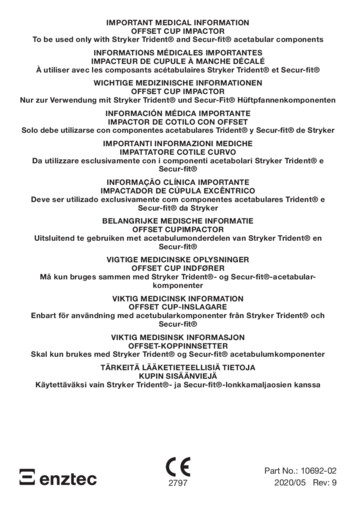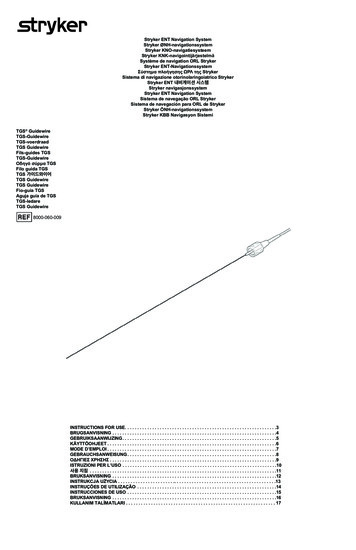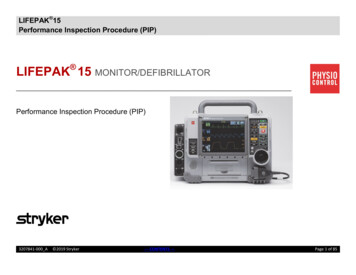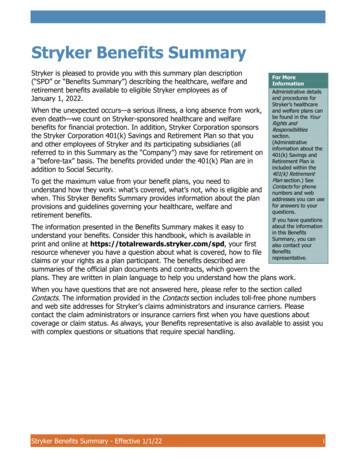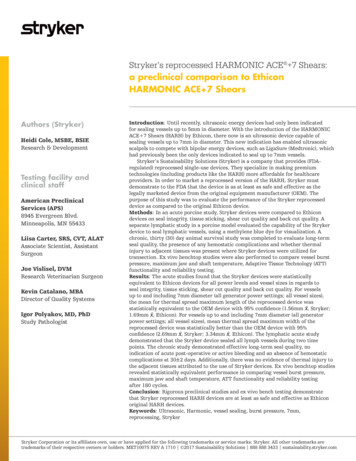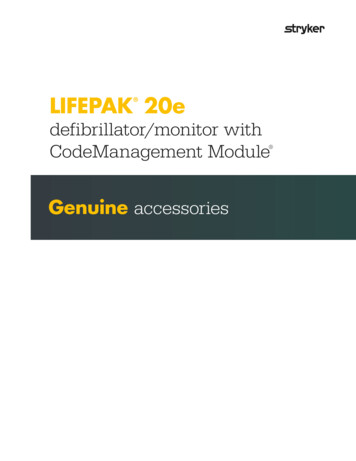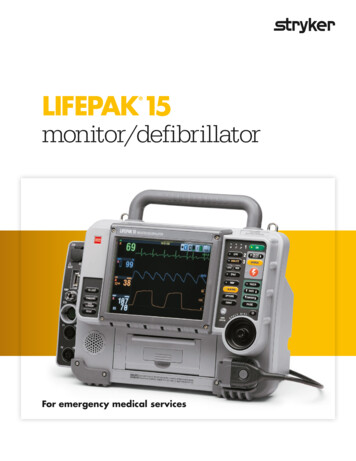
Transcription
LIFEPAK 15monitor/defibrillator For emergency medical services
LIFEPAK15 monitor/defibrillatorWhen you respond to emergencies,you need the most advanced monitor/defibrillator that sets the standard ininnovation, operations and toughness.
The LIFEPAK 15monitor/defibrillator deliversPhysio-Control defibrillators have set the standard for sixdecades, and the latest version of the LIFEPAK 15 monitor/defibrillator raises the bar. As our most advanced emergencyresponse monitor/defibrillator, the LIFEPAK 15 device balancessophisticated clinical technologies and supreme ease of usein a device that’s tough enough to stand up to your mostchallenging environments. Evolving from its original platform,the LIFEPAK 15 features temperature monitoring and externalpower to complement 360J of energy and 12-lead ECGtransmission capability. And that means your team can beeven more effective.A LIFEPAK device never stands on its own—and the LIFEPAK 15monitor is no different. Physio-Control is committed to providinginnovative solutions for emergency response care, from firstresponders to throughout the hospital.Our products have helped save tens of thousands oflives. We’re proud to continue this work with thefeatures in the LIFEPAK 15 monitor/defibrillator.
LIFEPAK15 monitor/defibrillatorThe standard inclinical innovationThe pioneer in portable defibrillation and monitoring technology,Physio-Control is committed to creating technologies and devicesthat change the way you provide emergency care. You can seethe results in the latest version of the LIFEPAK 15 monitor/defibrillator,which sets the standard in innovation—yet again.
Advanced monitoring parametersWith more monitoring capabilities than any other monitor/defibrillator, the LIFEPAK 15 gives you EtCO2 withcontinuous waveform capture. Masimo Rainbow technology helps you detect hard-to-diagnose conditionsand improve patient care with noninvasive monitoring of carbon monoxide, SpO2 andmethemoglobin. In addition, the LIFEPAK 15 offers temperature monitoring—and like otherdata, you can transmit it to other systems, trend it, or display for post-event review inCODE-STAT data review software. Advanced support for treating cardiac patientsThe LIFEPAK 15 continuously monitors all 12 leads in the background and alerts you to changes using the STSegment trend monitoring feature, after acquiring the initial 12-lead. Additionally, STJ values are included onthe 12-lead printout to help you identify changes. The LIFEPAK 15 also works seamlessly with the web-basedLIFENET System 5.0, so you can automatically share critical patient data with multiple patient care teams.Full energy up to 360 joules, for every patient who needs itThe LIFEPAK 15 monitor/defibrillator features 360J biphasic technology, which gives you the option of escalatingyour energy dose up to 360J for difficult-to-defibrillate patients. Why is this necessary? Recent studies have shownthat refibrillation is common among VF cardiac arrest patients and that defibrillation of recurring episodes of VFis increasingly difficult. A randomized controlled clinical trial shows the rate of VF termination was higherwith an escalating higher energy regimen of 200J and over.1Proven CPR guidance and post event reviewThe CPR Metronome in the LIFEPAK 15 monitor uses audible prompts to guide you without distracting vocalcritique. A metronome has been a feature that has been demonstrated to help professionals perform compressionsand ventilations within the recommended range of the 2015 AHA Guidelines. Post-event review of CPR data anddelivering feedback to the team has been shown to be effective in improving CPR quality in both hospital andout-of-hospital. And by transmitting code data directly to CODE-STAT Data Review software, EMS personnel canreview CPR statistics and provide training and feedback where it is most needed.2,3,4Post-event review of CPR data and deliveringfeedback to the team has been shown to beeffective in improving CPR quality in bothhospital and out-of-hospital.2,3,4
LIFEPAK15 monitor/defibrillatorThe standard inoperational effectivenessFlexible, connected and easy to use, the LIFEPAK 15 monitor/defibrillator was designed based on the feedback and needs specificto working in the field.Dual-mode LCD screen with SunVue display Switch from full-color to high-contrast SunVue mode with a single touch for the best fullglare view in the industry. A large screen (8.4 inches diagonally) and full-color display providemaximum viewability from all angles.Flexible power optionsChoose between external worldwide AC or DC power, or use the latest Lithium-ion dualbattery technology for up to six hours of power. The LIFEPAK 15 monitor’s two-battery systemrequires no maintenance or conditioning, and allows you to charge batteries in the device. Inaddition, you can track the status and service life of your batteries using LIFENET Asset, part ofthe LIFENET System data network. Data connectivityThe LIFEPAK 15 collects code summaries and equipment status data along with critical clinicalinformation as you treat patients. Using LIFENET Connect, part of the LIFENET System datanetwork, the code summaries can be sent directly to your quality improvement team for reviewwith CODE-STAT Data Review Software. Your equipment manager can also view equipmentstatus on the LIFENET System 5.0 using LIFENET Asset and alert you to any potential issues.Upgradable platformThe LIFEPAK 15 platform is flexible enough to adapt to evolving protocols and new guidelines,and can be upgraded as you’re ready to deliver new capabilities. With more processing powerand speed, the LIFEPAK 15 is designed to grow as your needs change, helping you avoid costlypremature replacements.Attention to detailThe LIFEPAK 15 monitor is designed based on field feedback to make it a more effective tool.The LIFEPAK 15 has a larger handle for easier handoffs, an easy to clean keypad, and a commoninterface to the LIFEPAK 12 defibrillator/monitor that helps reduce training.Code summaries can be sent directly to your quality improvement team forreview with CODE-STAT Data Review Software.
LIFEPAK15 monitor/defibrillatorThe standard intoughnessWe believe LIFEPAK equipment should live up to the highestexpectations of those working in the harshest settings. TheLIFEPAK 15 is LIFEPAK TOUGH , with improved ruggednessand durability you can rely on.Works when dropped, kicked, soaked or dirtyThe LIFEPAK 15 monitor/defibrillator passes 30-inch drop tests, which is equal to falling offa cot or dropping it in transit. And with an IP44 rating, it doesn’t matter how wet or dirty it gets,so you can keep working in steady wind, rain and other harsh environments.Toughened inside and outWe heard from emergency response teams that they wanted a tougher device—so we added ashock-absorbing handle, a double-layer screen that can take a beating from doorknobs and cothandles, and redesigned cable connections for confident monitoring and therapy delivery.Unmatched field serviceThe unit’s self-checking feature alerts our service team if the device needs attention. Our on sitemaintenance and repair, access to original manufacturer parts, and highly trained, experiencedservice representatives give you the peace of mind that your LIFEPAK 15 monitor will be readywhen you need it.*Data connectivityLIFEPAK TOUGH *A variety of customized service options are available.Dual-mode LCD screen withSunVue display
LIFEPAK15 monitor/defibrillatorThe latest lithium-ion battery technology and dual battery system allowsfor nearly six hour run time, automatic switching between external powerand batteries and an approximate two-year replacement cycle.Easy one-touch Bluetoothdata transmission. 12-lead ECG transmissionsvia the LIFENET System andST-Segment trend monitoringmake the LIFEPAK 15 unit a vitalpart of decreasing EMS-toballoon (E2B) response times.Integrated carbonmonoxide andmethemoglobinmonitoring.On-screen temperature displayin either Celsius or Fahrenheit.Large screen for better visibility and easymonitoring and one touch to switch from LCD colorview to SunVue mode for best viewing in sunlight.
Ergonomically designed handle has built-inshock absorbers for cushion and fits twogloved hands for easy pass off.CPR metronome, a proven technologythat actively guides users to a consistentcompression rate without the need forextra external hardware.Integrated Oridion EtCO2 provides waveformranges as low as 0-20 mmHg to help identifyROSC or gauge CPR quality, consistent withthe AHA guidelines.The LIFEPAK 15 monitor/defibrillator at a glanceRedesigned cable connector forconfidence in secure therapy delivery.
LIFEPAK15 monitor/defibrillatorFor six decades, Physio-Control has been developingtechnologies and designing devices that arelegendary among first response professionals,clinical care providers, and the community.
A legacy of trustSince we were founded in 1955, Physio-Control has been givingmedical professionals around the world legendary quality andconstant innovation. Our LIFEPAK devices have been carried tothe top of Mount Everest. They’ve been launched into orbit onthe International Space Station. And you’ll find more than halfa million units in use today on fire rescue rigs, ambulances, andhospital crash carts worldwide.We are inspired and informed by the rescuers who choose ourproducts to save lives. The knowledge gained from workingwith some of the world’s largest EMS organizations helps usconstantly improve clinical standards and durability.Today, we continue our legacy of innovation with leadingtechnologies that improve patient care. Our 360J biphasictechnology gives patients the best chance at survival. Oursecure, web-based flow of ECG data helps improve STEMIpatient outcomes. And our carbon monoxide monitoring helpscatch the number one cause of poisoning deaths.From the streets to the emergency room to the administrativeoffice, we offer a powerful suite of solutions that range fromcode response to quality control analysis. And even as we bringground-breaking products to the market, some things don’tchange. As always, when you choose our products, you don’t justget a device. You also get the most comprehensive warranty inthe business, industry-leading technical service, and a partnerwith six decades of experience in emergency care.For more information about the LIFEPAK 15 monitor/defibrillator—and how it can help you do what youdo best—please contact your local Physio-Controlrepresentative or visit www.physio-control.com.
SpecificationsGeneralMonitorThe LIFEPAK 15 monitor/defibrillator has sixmain operating modes:AED mode: for automated ECG analysis anda prompted treatment protocol for patients incardiac arrest.Manual mode: for performing manual defibrillation,synchronized cardioversion, noninvasive pacing, andECG and vital sign monitoring.Archive mode: for accessing stored patient information.Setup mode: for changing default settings of theoperating functions.Service mode: for authorized personnel to performdiagnostic tests and calibrations.Demo mode: for simulated waveforms and trendgraphs for demonstration purposes.ECGPhysical characteristicsWeight: Basic monitor/defibrillator with new roll paperand two batteries installed: 17.5 lb (7.9 kg) Fully featured monitor/defibrillator with newroll paper and two batteries installed: 18.5 lb(8.4 kg)Lithium-ion battery: 1.3 lb (0.6 kg)Accessory bags and shoulder strap: 3.9 lb (1.77 kg)Standard (hard) paddles: 2.1 lb (0.95 kg)Height: 12.5 in (31.7 cm)Width: 15.8 in (40.1 cm)Depth: 9.1 in (23.1 cm)DisplaySize (active viewing area): 8.4 in (212 mm)diagonal; 6.7 in (171 mm) wide x 5.0 in (128 mm) highResolution: display type 640 dot x 480 dot colorbacklit LCDUser selectable display mode: full color orSunVue display high contrastDisplay: a minimum of 5 seconds of ECG and alphanumerics for values, device instructions, or promptsDisplay: up to three waveformsWaveform display sweep speed: 25 mm/sec forECG, Sp02, IP, and 12.5 mm/sec for CO2Data managementThe device captures and stores patient data,events (including waveforms and annotations),and continuous waveform and patient impedancerecords in internal memory.The user can select and print reports, andtransfer the stored information via supportedcommunication methods.Report types: Three format types of CODE SUMMARY critical event record: short, medium, and long 12-lead ECG with STEMI statements Continuous Waveform (transfer only) Trend Summary Vital Sign Summary SnapshotMemory capacity: Total capacity is 360 minutesof continuous ECG, 90 minutes of continuous datafrom all channels, or 400 single waveform events.Maximum memory capacity for a single patientincludes up to 200 single waveform reports and90 minutes of continuous ECG.CommunicationsThe device is capable of transferring data recordsby wired or wireless connection. This devicecomplies with Part 15 of the FCC rules, and itsoperation is subject to the following two conditions:(1) this device may not cause harmful interference,and (2) this device must accept any interferencereceived, including interference that may causeundesired operation. Serial Port RS232 communication 12V available Limited to devices drawing maximum0.5 A current Bluetooth technology provides short-rangewireless communication with other Bluetoothenabled devices ECG is monitored via several cablearrangements:A 3-wire cable is used for 3-lead ECG monitoring.A 5-wire cable is used for 7-lead ECG monitoring.A 10-wire cable is used for 12-lead ECG acquisition.When the chest electrodes are removed, the 10-wirecable functions as a 4-wire cable.Standard paddles or QUIK-COMBO pacing/defibrillation/ECG electrodes are used for paddleslead monitoring.Frequency response: Monitor: 0.5 to 40 Hz or 1 to 30 Hz Paddles: 2.5 to 30 Hz 12-lead ECG diagnostic: 0.05 to 150 HzLead selection: Leads I, II, III, (3-wire ECG cable) Leads I, II, III, AVR, AVL, and AVF acquiredsimultaneously (4-wire ECG cable) Leads I, II, III, AVR, AVL, AVF, and C leadacquired simultaneously (5-wire ECG cable) Leads I, II, III, AVR, AVL, AVF, V1,V2,V3,V4,V5,and V6 acquired simultaneously (10-wireECG cable)ECG size: 4, 3, 2.5, 2, 1.5, 1, 0.5, 0.25 cm/mV(fixed at 1 cm/mV for 12-lead)Heart rate display: 20–300 bpm digital display Accuracy: 4% or 3 bpm, whichever is greater QRS Detection Range Duration: 40 to 120 msec Amplitude: 0.5 to 5.0 mCommon mode rejection (CMRR): ECG Leads:90 dB at 50/60 HzSp0 2 /SpC0/SpMetSensors: MASIMO sensors including RAINBOW sensors NELLCOR sensors when used with theMASIMO RED MNC adapterSp0 2 Displayed saturation range: “ 50” for levelsbelow 50%; 50 to 100%Saturation accuracy: 70–100% (0–69% unspecified)Adults/pediatrics: 2 digits (during no motion conditions) 3 digits (during motion conditions)Dynamic signal strength bar graphPulse tone as Sp02 pulsations are detectedSp02 update averaging rate user selectable:4, 8, 12 or 16 secondsSp02 sensitivity user selectable: Normal, HighSp02 measurement: Functional Sp02 values aredisplayed and storedPulse rate range: 25 to 240 bpmPulse rate accuracy (adults/pediatrics): 3 digits (during no motion conditions) 5 digits (during motion conditions)Optional Sp02 waveform display withautogain controlSpC0 SpC0 concentration display range: 0 to 40%SpC0 accuracy: 3 digitsSpMET SpMet saturation range: 0 to 15.0%SpMet display resolution: 0.1% up to 10%SpMet accuracy: 1 digitNIBPBlood pressure systolic pressure range: 30 to255 mmHgDiastolic pressure range: 15 to 220 mmHgMean arterial pressure range: 20 to 235 mmHgUnits: mmHgBlood pressure accuracy: 5 mmHgBlood pressure measurement time: 20 seconds,typical (excluding cuff inflation time)Pulse rate range: 30 to 240 pulses per minutePulse rate accuracy: 2 pulses per minute or 2%, whichever is greaterOperation features initial cuff pressure: Userselectable, 80 to 180 mmHgAutomatic measurement time interval: Userselectable, from 2 min to 60 minAutomatic cuff deflation excessive pressure:If cuff pressure exceeds 290 mmHgExcessive time: If measurement time exceeds120 secondsCO 2CO2 range: 0 to 99 mmHg (0 to 13.2 kPa)Units: mmHg, %, or kPaRespiration rate accuracy: 0 to 70 bpm: 1 bpm 71 to 99 bpm: 2 bpmRespiration rate range: 0 to 99 breaths/minuteRise time: 190 msecResponse time: 3.3 seconds (includes delay timeand rise time)Initialization time: 30 seconds (typical),10-180 secondsAmbient pressure: automatically compensatedinternallyOptional display: CO2 pressure waveform Scale factors: Autoscale, 0–20 mmHg (0–4 Vol%),0–50 mmHg (0–7 Vol%), 0–100 mmHg (0–14 Vol%)Invasive pressureTransducer type: Strain-gauge resistive bridgeTransducer Sensitivity: 5µV/V/mmHgExcitation voltage: 5 VdcConnector: Electro Shield: CXS 3102A 14S-6SBandwidth: Digital filtered, DC to 30 Hz ( -3db)Zero drift: 1 mmHg/hr without transducer driftZero adjustment: 150 mmHg includingtransducer offsetNumeric accuracy: 1 mmHg or 2% of reading,whichever is greater, plus transducer errorPressure range: -30 to 300 mmHg, in six userselectable rangesInvasive pressure displayDisplay: IP waveform and numericsUnits: mmHgLabels: P1 or P2, ART, PA, CVP, ICP, LAP(user selectable)TemperatureRange: 76.6 to 113.4 F (24.8 to 45.2 C)Resolution: 0.1 CAccuracy: 0.2 C including sensorReusable temperature cable: 5 foot or 10 footDisposable sensor types: Surface–Skin;Esophageal/RectalTrendTime scale: Auto, 30 minutes, 1, 2, 4, or 8 hoursDuration: Up to 8 hoursST segment: After initial 12-lead ECG analysis,automatically selects and trends ECG lead with thegreatest ST displacementDisplay choice of: HR, PR (SpO2), PR (NIBP),SpO2 (%), SpCO (%), SpMet (%), CO2 (EtCO2 /FiCO2),RR (CO2), NIBP, IP1, IP2, STAlarmsQuick set: Activates alarms for all active vital signsVF/VT alarm: Activates continuous (CPSS)monitoring in Manual modeNo breath alarm: Occurs when 30 seconds haselapsed since last detected respirationHeart rate alarm limit range: Upper, 100–250bpm; lower, 30–150 bpmInterpretive algorithm12-Lead interpretive algorithm: University ofGlasgow 12-Lead ECG Analysis Program, includesAMI and STEMI statementsPrinterPrints continuous strip of the displayed patientinformation and reportsPaper size: 3.9 in (100 mm)
Print speed: 25 mm/sec or 12.5 mm/sec Optional: 50 mm/sec time base for 12-leadECG reportsDelay: 8 secondsAutoprint: Waveform events print automaticallyFrequency response: Diagnostic: 0.05 to 150 Hz or 0.05 to 40 Hz Monitor: 0.67 to 40 Hz or 1 to 30 HzDefibrillatorBiphasic waveform: Biphasic TruncatedExponentialThe following specifications apply from 25 to200 ohms, unless otherwise specified:Energy accuracy: 1 joule or 10% of setting,whichever is greater, into 50 ohms, 2 joules or 15%of setting, whichever is greater, into 25-175 ohms.Voltage compensation: Active when disposabletherapy electrodes are attached. Energy outputwithin 5% or 1 joule, whichever is greater, of 50ohms value, limited to the available energy whichresults in the delivery of 360 joules into 50 ohms.Paddle options: QUIK-COMBO pacing/defibrillation/ECG electrodes (standard). CableLength 8 foot long (2.4 m) QUIK-COMBO cable(not including electrode assembly).Standard paddles (optional)Manual mode Energy select: 2, 3, 4, 5, 6, 7, 8, 9, 10, 15, 20, 30,50, 70, 100, 125, 150, 175, 200, 225, 250, 275, 300,325, and 360 joulesCharge time: Charge time to 360 joules in lessthan 10 seconds, typicalSynchronous cardioversion: Energy transferbegins within 60 msec of the QRS peakPaddles leads off sensing: When usingQUIK-COMBO electrodes, the device indicatesPaddles Leads Off if the resistive part of thepatient impedance is greater than 300 15% ohms,or if the magnitude of the patient impedance isgreater than 440 15% ohms.AED ModeShock Advisory System (SAS): an ECG analysissystem that advises the operator if the algorithmdetects a shockable or non-shockable ECG rhythm.SAS acquires ECG via therapy electrodes only.Shock ready time: Using a fully charged batteryat normal room temperature, the device is readyto shock within 20 seconds if the initial rhythmfinding is “SHOCK ADVISED”Biphasic output: Energy Shock levels rangingfrom 150–360 joules with same or greater energylevel for each successive shockcprMAX Technology: In AED mode, cprMAX technology provides a method of maximizing theCPR time that a patient receives, with the overallgoal of improving the rate of survival of patientstreated with AEDs.Setup options: Auto Analyze: Allows for auto analysis.Options are OFF, AFTER 1ST SHOCK Initial CPR: Allows the user to be prompted forCPR for a period of time prior to other activity.Options are OFF, ANALYZE FIRST, CPR FIRST Initial CPR Time: Time interval for InitialCPR. Options are 15, 30, 45, 60, 90, 120, and180 seconds. Pre-Shock CPR: Allows the user to beprompted for CPR while the device is charging.Options are OFF, 15, 30 seconds. Pulse Check: Allows the user to be promptedfor a pulse check at various times. Optionsare ALWAYS, AFTER EVERY SECOND NSA,AFTER EVERY NSA, NEVER Stacked Shocks: Allows for CPR after 3consecutive shocks or after a single shock.Options are OFF, ON CPR Time: 1 or 2 User selectable times for CPR.Options are 15, 30, 45, 60, 90, 120, 180 secondsand 30 minutes.PacerPacing mode: Demand or non-demand rate andcurrent defaultsPacing rate: 40 to 170 PPMRate accuracy: 1.5% over entire rangeOutput waveform: Monophasic, truncatedexponential current pulse (20 1 ms)Output current: 0 to 200 mAPause: Pacing pulse frequency reduced by a factorof 4 when activatedRefractory period: 180 to 280 msec (functionof rate)EnvironmentalUnit meets functional requirements duringexposure to the following environmentsunless otherwise stated.Operating temperature: 32 to 113 F (0 to45 C); -4 F (-20 C) for 1 hour after storage atroom temperature; 140 F (60 C) for 1 hour afterstorage at room temperatureStorage temperature: -4 to 149 F (-20 to 65 C)except therapy electrodes and batteriesRelative humidity, operating: 5 to 95%, noncondensing. NIBP: 15 to 95%, non-condensingRelative humidity, storage: 10 to 95%,non-condensingAtmospheric pressure, operating: -1,253 to15,000 ft (-382 to 4,572 m). NIBP: -500 to 10,000 ft(-152 to 3,048 m)Water resistance, operating: IP44 (dust andsplash resistance) per IEC 529 and EN 1789(without accessories except for 12-lead ECG cable,hard paddles, and battery pack)Vibration: MIL-STD-810E Method 514.4, PropellerAircraft - category 4 (figure 514.4-7 spectrum a),Helicopter - category 6 (3.75 Grms), Ground Mobile- category 8 (3.14 Grms), EN 1789: SinusoidalSweep, 1 octave/min, 10-150 Hz, 0.15 mm/2 gShock (drop): 5 drops on each side from 18 inchesonto a steel surface EN 1789: 30-inch drop ontoeach of 6 surfacesShock (functional): Meets IEC 60068-2-27 andMIL-STD-810E shock requirements 3 shocks perface at 40 g, 6 ms half-sine pulsesBump: 1000 bumps at 15 g with pulse duration of6 msecImpact, non-operating: EN 60601-1 0.5 0.05 joule impact UL 60601-1 6.78 Nm impactwith 2-inch diameter steel ball. Meets IEC62262protection level IK 04.EMC: EN 60601-1-2:2006 Medical Equipment-General Requirements for Safety - CollateralStandard: Electromagnetic Compatibility Requirements and Tests EN 60601-2-4:2003:(Clause 36) Particular Requirements for theSafety of Cardiac Defibrillators and CardiacDefibrillator-MonitorsCleaning: Cleaning 20 times with the following:Quaternary ammonium, isopropyl alcohol,hydrogen peroxideChemical resistance: 60 hour exposure tospecified chemicals: Betadine (10% PovidoneIodine solution), Coffee, Cola, Dextrose (5%Glucose solution), Electrode Gel/Paste (98% water,2% Carbopol 940), HCL (0.5% solution, pH 1),Isopropyl Alcohol, NaCl solution (0.9% solution),Cosmetic discoloration of the paddle well shortingbar shall be allowed following exposure to HCL(0.5% solution).PowerPower adapters: AC or DCPower Adapters provide operation and batterycharging from external AC or DC power Full functionality with or without batterieswhen connected to external AC/DC Typical battery charge time while installed inLIFEPAK 15 device is 190 minutes Indicators: external power indicator, batterycharging indicatorDual battery: Capability with automatic switchingLow battery indication and message: Lowbattery fuel gauge indication and low batterymessage in status area for each batteryReplace battery indication and message:Replace battery fuel gauge indication, audio tonesand replace battery message in the status area foreach battery. When replace battery is indicated,device auto-switches to second battery. When bothbatteries reach replace battery condition, a voiceprompt instructs user to replace battery.Battery capacityFor two, new fully-charged batteries, 68 F (20 C)OperatingmodeMonitoring Pacing(minutes)TotalTypicalcapacityto shutdown MinimumCapacityafter attery specificationsBattery type: Lithium-ionWeight: 1.3 lb (0.6 kg)Charge time (with fully depleted battery):4 hours and 15 minutes (typical)Battery indicators: Each battery has a fuel gaugethat indicates its approximate charge. A fuel gaugethat shows two or fewer LEDs after a charge cycleindicates that the battery should be replaced.Charging temperature range: 41 to 113 F(5 to 45 C)Operating temperature range: 32 to 113 F(0 to 45 C)Short term ( 1 week) storage temperaturerange: -4 to 140 F (-20 to 60 C)Long term ( 1 week) storage temperaturerange: 68 to 77 F (20 to 25 C)Operating and storage humidity range:5 to 95% relative humidity, non-condensing
References1. Stiell I, Walker R, Nesbitt L, et al. Biphasic Trial: A randomized comparison of fixed lower versus escalatinghigher energy levels for defibrillation in out-of-hospital cardiac arrest. Circulation. 2007;115:1511-1517.2. Edelson D, Litzinger B, Arora V, et al. Improving in-hospital cardiac arrest process and outcomes withperformance debriefing. Arch Intern Med. 2008;168:1063-1069.3. Olasveengen T, Wik L, Kramer-Johansen J, et al. Is CPR quality improving? A retrospective study of out-ofhospital cardiac arrest. Resuscitation. 2007;75:260-266.4. Fletcher D, Galloway R, Chamberlain D, et al. Basics in advanced life support: A role for download audit andmetronome. Resuscitation. 2008;78:127-134.All claims valid as of August 2018.Physio-Control is now part of Stryker.For further information, please contact Physio-Control at 800.442.1142 (U.S.), 800.668.8323 (Canada) or visit ourwebsite at www.physio-control.comPhysio-Control Headquarters11811 Willows Road NERedmond, WA 98052www.physio-control.comCustomer SupportP. O. Box 97006Redmond, WA 98073Toll free 800 442 1142Fax 800 426 8049Physio-Control CanadaPhysio-Control Canada Sales, Ltd.45 Innovation DriveHamilton, ONL9H 7L8CanadaToll free 800 668 8323Fax 877 247 7925Physio-Control, Inc., 11811 Willows Road NE, Redmond, WA 98052 USA 2018 Physio-Control, Inc. Not all products and services are available in all countries. Specifications subject to change without notice. All names herein are trademarks or registeredtrademarks of their respective owners. Masimo, the Radical logo, Rainbow and SET are registered trademarks of Masimo Corporation.GDR 3301019 H
Large screen for better visibility and easy monitoring and one touch to switch from LCD color view to SunVue mode for best viewing in sunlight. On-screen temperature display in either Celsius or Fahrenheit. Integrated carbon monoxide and methemoglobin monitoring. 12-lead ECG transmissions via the LIFENET System and ST-Segment trend monitoring
